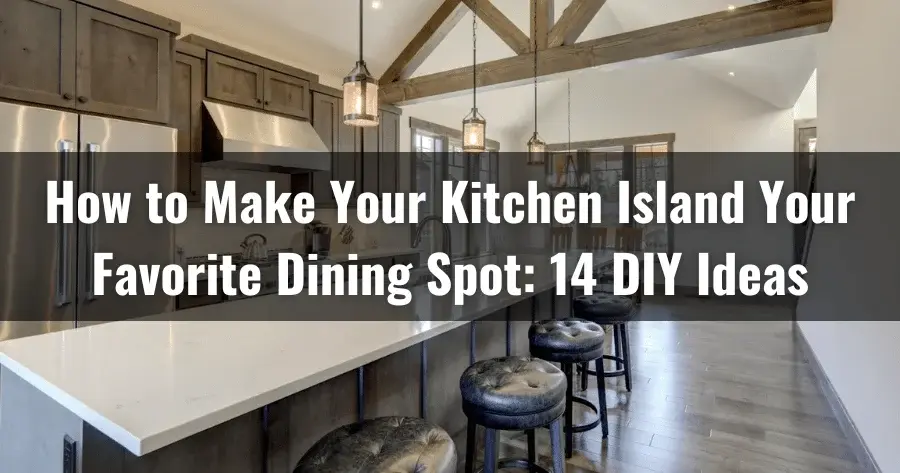A kitchen island makes a great dining area because it is versatile, convenient, and adds a touch of elegance to the room. Whether you have a small or large kitchen, there is always room for an island that doubles as a dining table.
By following some basic rules, such as selecting the right height and size for your island, incorporating comfortable seating options, can turn your kitchen island into the ultimate dining destination. Adding decorative elements that reflect your personal style, you can create a space that is both inviting and practical.
The key to creating the perfect layout is ensuring that it complements the existing design and functionality of your kitchen. With a few simple DIYs, you can create a cozy and inviting space to make mealtime a delightful experience.
So keep reading and get ready to enjoy delicious meals in style with DIY ideas.
Jump to Section
How to Make Your Kitchen Island Your Favorite Dining Spot: 14 DIYs
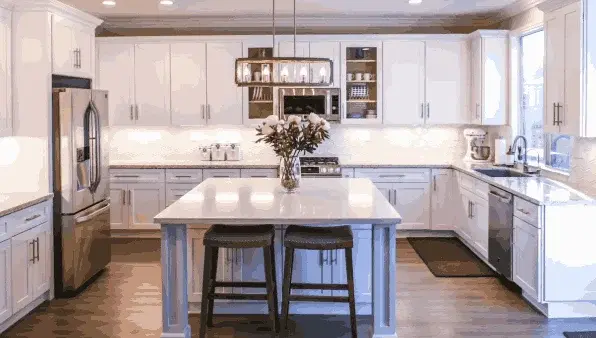
You can transform your kitchen island into your dream dining spot with these 14 DIY ideas.
The details are as follows:
Consider a Comfortable Seating Area
When creating a comfortable seating area, opt for stylish and ergonomic barstools or counter-height chairs to transform your kitchen island into a cozy and inviting dining spot.
These seating options embellish your space and provide comfort for enjoying meals with family and friends. Choose stools or chairs that resemble traditional dining chairs, as they tend to be more comfortable for extended periods of sitting.
Incorporate Chairs With Backs
Choose chairs with backs for your kitchen island and create a cozy, inviting atmosphere that’ll make you never want to leave. Chairs with backs provide more comfort for longer meals and give the island a ‘dining room’ vibe.
When selecting chairs, consider the style and material complementing your kitchen decor. Upholstered chairs add an extra level of comfort, while wooden or metal chairs can bring a rustic or modern touch to the space.
Try to Maximize Legroom
Maximizing legroom is crucial for creating a comfortable and enjoyable dining experience. Regarding your kitchen island, ensuring enough space for everyone to sit comfortably is important.
According to experts, a recommended minimum overhang of 6 inches should be aimed for, while 9 to 12 inches of legroom is considered ideal. This will allow diners to stretch their legs without feeling cramped or restricted.
Organizing the Elbow Room
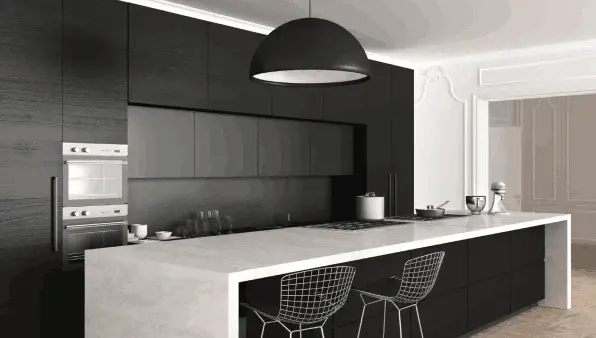
To create a comfortable and spacious dining experience, organize the elbow room by ensuring ample space for each guest. When planning your kitchen island as a dining spot, remember that providing 30 inches of space per person is crucial to avoid feeling cramped during meals.
Avoid overcrowding the island with unnecessary items or decorations that may take up valuable elbow room. Also, consider using narrower chairs that can fit easily under the island’s edge when not in use, maximizing legroom and creating a more open and inviting atmosphere.
Tying Fabric to Cabinetry
When creating a cohesive kitchen design, tying the fabric color of the chairs to the cabinetry adds a touch of unity and style. By selecting chair fabrics that complement or match the color of your cabinetry, you create a seamless look in your kitchen.
Select fabrics that harmonize with your cabinetry, and consider the overall aesthetic of your kitchen when selecting fabrics. For example, if you have white cabinets, opt for light-colored or neutral fabric for your chairs to maintain a clean and airy feel.
Building Extended Islands
With an extended island that offers extra seating and a custom look in your kitchen, mealtime can be a lot more fun. Deeply extended tops on islands provide ample space for seats on multiple sides, allowing guests to chat easily while you prepare meals.
This arrangement is particularly useful in long, narrow kitchens where the island can be expanded in a single direction to create a dining-table-length space adjacent to the primary work surface.
Think about a Circular Table
If you want to create a kitchen island that becomes your favorite dining spot, consider thinking outside the box and opting for a circular table. Circular tables not only add a touch of elegance and style to your kitchen, but they also offer practical benefits.
With a circular table, you can move seats around as needed, making it easier to accommodate different group sizes or rearrange your seating arrangement for various occasions.
Custom Look With Islands
Create a unique and personalized aesthetic by incorporating custom islands into your kitchen design. Islands with a node or bubble create a dining space that’s functional and visually appealing.
These custom islands allow guests to face one another and the chef, creating an intimate dining experience. They’re perfect for smaller spaces as they require less surface area than a standalone circular table.
Matching the Counter
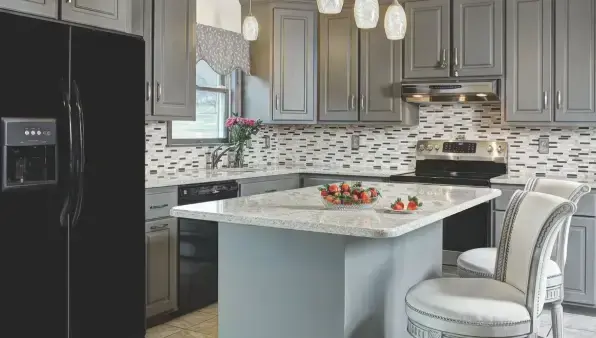
To achieve a polished and cohesive look in your kitchen, match the stone used for the counter with the top of your island. This simple yet effective design choice creates a custom look that elevates the overall aesthetic of your space.
Using the same stone for both surfaces creates a seamless transition between the counter and the island, giving them a unified appearance. This enhances visual appeal and adds an element of sophistication to your kitchen.
Picnic-Style Dining Area
A picnic-style dining area could be added against the back of your island to transform your kitchen into a vibrant and inviting space. This clever layout trick not only maximizes the efficiency of your kitchen but also creates an illusion of increased space.
Incorporating a picnic-style dining area provides a casual and relaxed meal atmosphere, perfect for entertaining guests and enjoying family dinners.
Furniture Islands Option
Opt for a budget-friendly alternative in smaller spaces by incorporating furniture islands using a dining table instead of a traditional island. This innovative approach not only saves money but also maximizes the functionality of your kitchen.
By replacing the standard island with a dining table, you create a versatile space that can be used for both food preparation and dining. The dining table is the centerpiece, providing ample seating for family and friends to gather during mealtimes.
Wood for Dining-Table Islands
Craft a warm and inviting atmosphere in your kitchen by incorporating a wooden dining-table island that seamlessly blends with any style. Wood is an excellent choice for dining-table islands as it offers versatility and contrasts well with other materials.
The natural texture and warmth of the wood create a cozy ambiance that encourages gathering around the table for meals and conversations. Additionally, wood is durable and long-lasting, making it ideal for daily use in the kitchen.
Tableware Accessories
Tableware accessories are essential for creating an elegant and special dining experience. Placemats, cloth napkins, and centerpieces are perfect additions to your kitchen island to transform it into your favorite dining spot.
By incorporating these tableware accessories into your kitchen island setup, you can enjoy truly special and memorable meals.
Using Light Fixtures
You can use light fixtures for more than just illumination, as they can also serve as stunning decorative pieces that enhance your kitchen’s overall aesthetics.
Pendant lights are an excellent choice for adding a touch of elegance and sophistication to your space. Opt for fixtures with adjustable heights to customize the lighting according to your needs.
Conversely, Chandeliers can make a bold statement and become the focal point of your kitchen. Consider ones with dimmable features, allowing you to control the brightness levels based on the occasion.
Can a kitchen island be a dining table?
A kitchen island can be converted into your favorite dining area, making it a multi-purpose space. Not only does it provide a convenient area for food preparation, but it can also serve as a stylish and comfortable dining table.
With the right setup, your kitchen island can offer a unique dining experience that is both functional and aesthetically pleasing.
Why do people like a kitchen island as a dining spot?
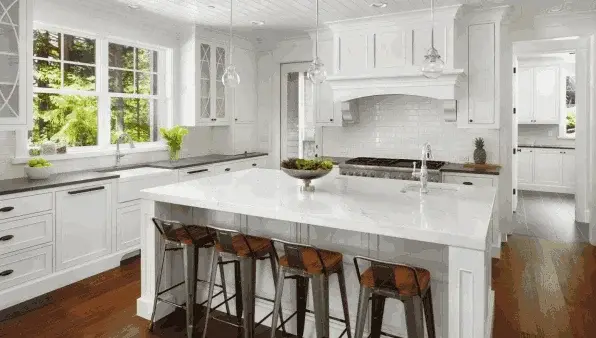
One of the main reasons why people like using a kitchen island as their favorite dining spot is because it offers more counter space. This means that you can spread out your plates, utensils, and food without feeling cramped.
With its added counter space, ample storage options, and the possibility of incorporating an appliance or small work sink, you’ll find that a kitchen island provides functionality and versatility as a dining area.
What is the best layout for the kitchen island?
As far as kitchen islands are concerned for dining spots, the most popular layout is having it positioned directly in the center of the kitchen. But this might not always be the most practical design.
If you use the island mostly for food preparation, it will make more sense to position it near power outlets and appliances you need easy access to. This will make prepping meals and cooking much more convenient for you.
What is the rule of the kitchen island for dining spots?
You may have envisioned your dream kitchen island transforming effortlessly into the perfect spot for family and friends to enjoy meals together. To achieve this, it’s important to follow the rule of thumb for kitchen islands used as dining spots: 24-30 inches per person.
This means you should have enough space on your kitchen island to accommodate each person seated around it comfortably. Adhering to this rule ensures that everyone has enough elbow room and can enjoy their meal without feeling cramped or uncomfortable.
FAQ’s
What kind of seating is best for a kitchen island?
The best seating for a kitchen island depends on your personal preference and the style of your kitchen. Some popular options include bar stools, backless stools, wicker chairs, or even a built-in bench.
Can I extend my kitchen island countertop?
Yes, you can extend your kitchen island countertop to create an additional dining space. This can be done by adding a round or rectangular extension to the original countertop, giving you more room for seating.
What materials can I use for my kitchen island countertop?
There are various materials you can use for your kitchen island countertop, such as quartz, marble, granite, or even a faux stone. Choose a material that suits your kitchen’s style and fits your budget.
How can I add storage to my kitchen island?
You can add storage to your kitchen island by incorporating open shelves, built-in cabinets, or drawers. This will help you keep your kitchen organized and provide a convenient place to store utensils, cookware, or pantry items.
Can I use my kitchen island as a separate dining area?
Yes, you can use your kitchen island as a separate dining area. By adding comfortable seating and creating a cozy ambiance, you can turn your kitchen island into a casual dining spot for meals with family and friends.
How can I make my narrow kitchen work for a kitchen island?
If you have a narrow kitchen, you can still make a kitchen island work by opting for a slim design that doesn’t take up too much space. Consider a curved or L-shaped island that fits the width of your kitchen and provides extra counter space.
How can I integrate my kitchen island with the rest of my kitchen?
To integrate your island with the rest of your kitchen, you can choose a color palette that matches or complements the existing cabinetry and countertops. Also, make sure the style and materials of your island blend well with the overall design of your kitchen.
Can I use my kitchen island for meal preparation?
Yes, your kitchen island can serve as a prep space for meal preparation. You can install a sink, a stove, or additional countertop space on your island, making it a convenient and functional area for cooking and food preparation.
How much clearance space do I need around my kitchen island?
It is recommended to have at least 36 inches of clearance space around your kitchen island to ensure easy movement and adequate circulation in the kitchen. However, in a narrower kitchen, 24 inches of clearance should be sufficient.
Conclusion: Create Your Dream Kitchen Island Dining Spot
Transforming your kitchen island into your favorite dining spot isn’t just possible but highly desirable. By following the DIYs provided above, you can create a functional and inviting space for meals with family and friends.
The versatility of a kitchen island as both a cooking and dining area makes it an attractive option for many homeowners. Remember to consider the layout and size of your kitchen when designing your island, and adhere to the rule of keeping enough space around it for comfortable movement.
Enjoy making unforgettable memories in your very own kitchen island dining spot.


